SpanTrack Lane Carton Flow Rollers
Efficient, durable, and dependable, SpanTrack Lane carton flow rollers drop into existing structures to create the ultimate carton flow rack system for manufacturing facilities and order picking operations.

Managing a warehouse or distribution center is a matter of precision. By reducing the time it takes for your employees to locate, pick, and deliver medium-throughput SKUs by even one second, you can:
Applying the same strategy to high-throughput and low-throughput SKUs will further amplify these benefits. It's essential to optimize every square foot of floor space, minimize the time spent searching for disorganized SKUs, and ensure that order pickers — who are on their feet for over eight hours a day —operate as efficiently as possible.
Labor costs constitute 60-80% of the total expenses in a order fulfillment and distribution operation, with a significant portion attributed to order picking activities. To reduce these costs, it's essential to concentrate on two key areas: reducing search time and minimizing travel time.
We have compiled a comprehensive list to assist you in achieving these objectives.
The initial step in optimizing your distribution center or warehouse involves the implementation of a “slotting system.” A well-executed slotting system make sure each SKU is stored in its optimal position, assigned a specific “address,” and organized based on its throughput. In the absence of such a system, order pickers may spend excessive time searching or retracing their steps to locate the necessary SKUs, leading to inefficiencies, increased risk of mispicks, and a negative impact on your bottom line and customer satisfaction due to late, or worse, wrong orders.
The following three tips are designed to reduce search time and mitigate these issues.
Without a slotting system in place where each SKU has its own optimal position, order pickers will face challenges similar to delivering a package to a seven-story apartment building with only the building's address. They know the package is intended for Mrs. Brown at 574 Smith St., but they lack the floor or apartment number. In other words, they are aware of the general area where the SKU is located in your warehouse but do not know the specific location.
How would they locate Mrs. Brown in that scenario? How would they deliver the package? They would need to go door to door. In your warehouse, they would need to search the general area SKU by SKU. Assigning a specific position to each SKU provides it with an address. The more specific the address, the better. “Fifth floor” is insufficient. “Fifth floor, Apartment E” would allow the order picker to go directly to the SKU, significantly reducing search time.
This simplifies the process for order pickers. Aisle two, bay two, position three should consistently house the same SKU. Otherwise, there could be a mispick, resulting in the wrong item being shipped to the customer. If you do nothing else to improve the organization of your warehouse or distribution center, implement this.
Once an address is determined for a SKU, all efforts should be made to make that a permanent home for the SKU. If space in your distribution center is limited and the highest-throughput SKUs change rapidly, you will need to consistently adjust so the highest-throughput SKUs always have the most accessible “addresses.”
When all SKUs have a unique address, the order picker receives a very specific pick ticket or verbal cue that includes the aisle number, bay number, and position number of the SKU (or a pick sheet showing the location of all the SKUs in an order) instead of a general location. They can then go directly to that location, pick the item, and quickly proceed to “shipping,” or whatever step is next in your operation.
After understanding the importance of assigning a physical address to each SKU, it is crucial to optimize storage methods to boost search efficiency. The appropriate storage solution—whether pallets, carton flow racks, or shelving—depends on the SKU’s throughput classification: low, medium, or high.
Low-throughput SKUs, which are infrequently ordered, do not need prime warehouse space but must still be easily accessible. Static shelving or a more ergonomic option should be used for these items.
Many distribution centers store low-throughput SKUs on static flat shelves within pallet racks. However, static shelves often result in awkward or dangerous picking situations. Workers may have to reach awkwardly or even climb to retrieve items, increasing the risk of injury.
At other times, order pickers might use a "shepherd hook" to pull an item forward from the back of a shelf. Although this method is safer, it considerably reduces worker efficiency, slows down the entire process, and raises operational costs.
To avoid these risks and inefficiencies, a better solution would be SpanTrack carton flow or gravity flow racks, which offers a gravity-fed, dynamic storage system. SpanTrack is designed to keep products accessible by moving items forward as the front items are picked. This not only eliminates the need for workers to stretch or climb but also allows for first-in, first-out (FIFO) inventory rotation, ensuring more efficient picking and replenishment.
SpanTrack easily integrates into existing pallet racks, so facilities using static shelving can retrofit them with this more efficient solution without needing to install new racking systems. Additionally, the ergonomic design of SpanTrack improves worker safety and efficiency while minimizing strain, which can lead to increased employee morale and lower operational costs.

For medium throughput SKUs, carton flow racks are the ideal solution. These racks use a gravity-fed system where cartons automatically move forward after a pick, ensuring that products are always within easy reach. They are positioned in a more prominent position than tilted shelving and often replace old structures that use inefficient plastic wheels.
A case study from a New York City-based online grocer illustrates the impact of customized carton flow solutions. Before partnering with UNEX, their outdated plastic-wheeled system caused frequent product hang-ups and inefficiencies. With SpanTrack, the grocer saw a dramatic improvement in both space utilization and pick rates. After the installation, they added 500 new SKUs within the same footprint, reduced product damage, and improved order picking efficiency.
Carton flow racks can also be customized to accommodate various SKU sizes and adjusted to optimize ergonomic picking windows, reducing strain on workers and minimizing the risk of injury.
For operations requiring more flexibility—such as those handling seasonal SKUs or products with varying carton sizes—UNEX offers SpanTrack Wheel Bed. These provide an uninterrupted flow, as opposed to the traditional dedicated lanes, giving operations the ability to quickly adapt to changes in inventory. This makes wheel beds ideal for businesses that need versatility in their storage without sacrificing efficiency.
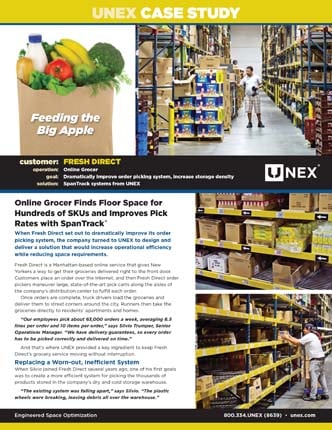
For high-throughput SKUs, it makes little sense to remove items from pallets, as they are picked so frequently. Instead, it’s more efficient to pick these products directly from the pallet.
UNEX Pallet Track offers a pitched surface that allows pallets to glide forward as the front pallet is emptied, making it easy for order pickers to access new stock without interruptions. This system significantly improves picking speed and ensures FIFO inventory rotation without the need for manual labor to move pallets forward. It’s a perfect solution for high-throughput environments where every second counts and efficiency is critical.
With Pallet Track, facilities can maximize the efficiency of their high-volume SKUs, reducing labor costs and operational bottlenecks. By simplifying the picking process and minimizing handling, this solution ensures a faster and safer work environment.
Piece-picking, also known as “each picking” or “split-case picking,” involves the selection of individual items from a carton to fulfill an order. Given that SKUs should be assigned a storage location, or “address,” based on their throughput, “piece picks” can be stored on shelves (low throughput), carton flow racks (medium throughput), or pallets (high throughput). In certain piece-picking processes, it's advisable to transfer high-throughput SKUs from pallets to carton flow racks, as individual pieces move quickly, but the cartons themselves may take longer to be removed from the pallet. In these instances, removing the pallet from the floor can create a more efficient space. Essentially, in these scenarios, high-throughput pieces correspond to medium-throughput cartons and can be treated as medium-throughput SKUs.
By organizing your SKUs based on throughput, implementing the most suitable flow solution, and considering whether the SKU is a piece pick or carton pick, you will significantly enhance efficiency. This approach will reduce pick time, decrease search time, lower overall costs, and increase overall profitability.
Reorganizing your warehouse and reducing search time based on these principles is an excellent initial step. Subsequent optimization involves making minor adjustments that save valuable seconds.
Having addressed how to reduce search time for your order pickers, the next crucial step in optimizing your distribution operation is reducing travel time.
Travel time refers to the duration your order pickers spend walking throughout their day to locate and retrieve SKUs necessary for order fulfillment. An unorganized distribution center can result in excessive walking, wasting valuable time and increasing labor costs. Meanwhile, a strategically planned distribution center will enable order pickers to spend more time picking and less time walking, increasing the number of orders fulfilled with greater accuracy and efficiency.
The following two tips will assist you in effectively mapping out your distribution center.
This recommendation may sound familiar as it closely aligns with the first tip for reducing search time, underscoring the importance of organizing your warehouse based on throughput. As previously discussed, assigning a unique physical address to each SKU is essential. But how do you determine the optimal physical address for a SKU?
The optimal address largely depends on the overall order fulfillment operation, which can vary significantly. However, in general, the address is determined by the throughput of the SKU.
For instance, all low-throughput SKUs should be stored in the same area of the warehouse. They don't need to be organized by product similarity (e.g., if you sell significantly more ketchup than mustard, they don't need to be stored near each other simply because they are both condiments). Instead, they should be organized by throughput. High-throughput ketchup should be left on pallets in high-accessibility locations, while low-throughput mustard should be moved to shelving in lower-accessibility locations.
This approach allows order pickers to always know where to find any low-throughput, medium-throughput, or high-throughput item. It also enables them to easily retrieve two frequently-ordered SKUs from the same location, significantly reducing travel time over the long term (as opposed to a scenario where two items with similar throughput are located at opposite ends of an aisle). This type of organization enhances efficiency by ensuring that all medium- and high-throughput SKUs are easily accessible in high-traffic areas of the warehouse, while all low-throughput SKUs are stored in lower-traffic areas. It also prevents low-throughput items from occupying valuable high-accessibility space, which improves overall efficiency, reducing costs, and increasing profitability.
Avoid the misconception that all similar items need to be stored together. For example, neutral paint colors will be picked much more frequently than hot pink. The focus should be on throughput, not item type.

This could be the most critical recommendation among the five, despite its seemingly understated significance. The impact of maintaining high morale and ensuring the safety of your order pickers is not easily quantifiable, but its influence extends beyond travel time. High morale fosters motivation and enthusiasm among workers, leading to enhanced job performance. By prioritizing the reduction of travel time, you demonstrate a commitment to their well-being.
Order pickers typically spend over eight hours a day on their feet, a demanding task. Investing in more efficient systems that reduce their walking time will be greatly appreciated, as it simplifies their work. More importantly, it empowers them to perform at their best. On the other side, neglecting these improvements can result in dissatisfied employees who are fatigued from excessive walking, forced to climb racks to retrieve items, and constantly stressed by an inefficient organizational scheme that hinders their ability to keep pace with orders.
A well-organized distribution center eliminates these frustrations, allowing employees to feel content knowing their time is well-utilized. They will take pride in maximizing their skills and work ethic.
To enhance the operational efficiency of warehouses and distribution centers, UNEX provides a range of solutions that directly address the critical issues of reducing search and travel times. These solutions not only improve productivity but also reduce overhead and increase employee morale.
A significant way to reduce search time is by implementing a slotting system that ensures each SKU has its designated place. SpanTrack, the industry-leading carton flow solution, optimizes SKU organization by providing highly efficient, reliable, and durable dynamic storage. SpanTrack is ideal for:
By equipping your distribution center with SpanTrack, you’ll ensure each SKU has a clear, accessible “address,” reducing mispicks and search time, all while maintaining product rotation and increasing overall efficiency.
For reducing travel time, UNEX SpeedCell solution maximizes space utilization and minimizes picker travel. This high-density storage system can compress 200 feet of rack or shelving into just 40 feet, drastically improving SKU density and reducing the time pickers spend walking around the facility. SpeedCell is:
With SpeedCell, you can significantly cut down on the travel time required to locate and pick items, increasing productivity by up to 40-60%.
For high-throughput SKUs, where speed is essential, Pallet Track allows employees to pick directly from the pallet, eliminating the need for double handling. This solution enables:
With Pallet Track, you can maximize efficiency for your most frequently ordered SKUs, ensuring that workers spend less time handling products and more time fulfilling orders.
For operations that require frequent piece-picking, Pick Shelves provide an ergonomic solution that keeps SKUs easily accessible. These shelves are designed to improve the efficiency of split-case or piece-picking operations by:
By incorporating Pick Shelves, you can reduce both search and travel time, while also promoting a safer and more efficient picking process for your team.
By implementing these UNEX solutions you can streamline your picking operations, reduce unnecessary labor costs, and create a safer, more efficient work environment.
Efficient, durable, and dependable, SpanTrack Lane carton flow rollers drop into existing structures to create the ultimate carton flow rack system for manufacturing facilities and order picking operations.
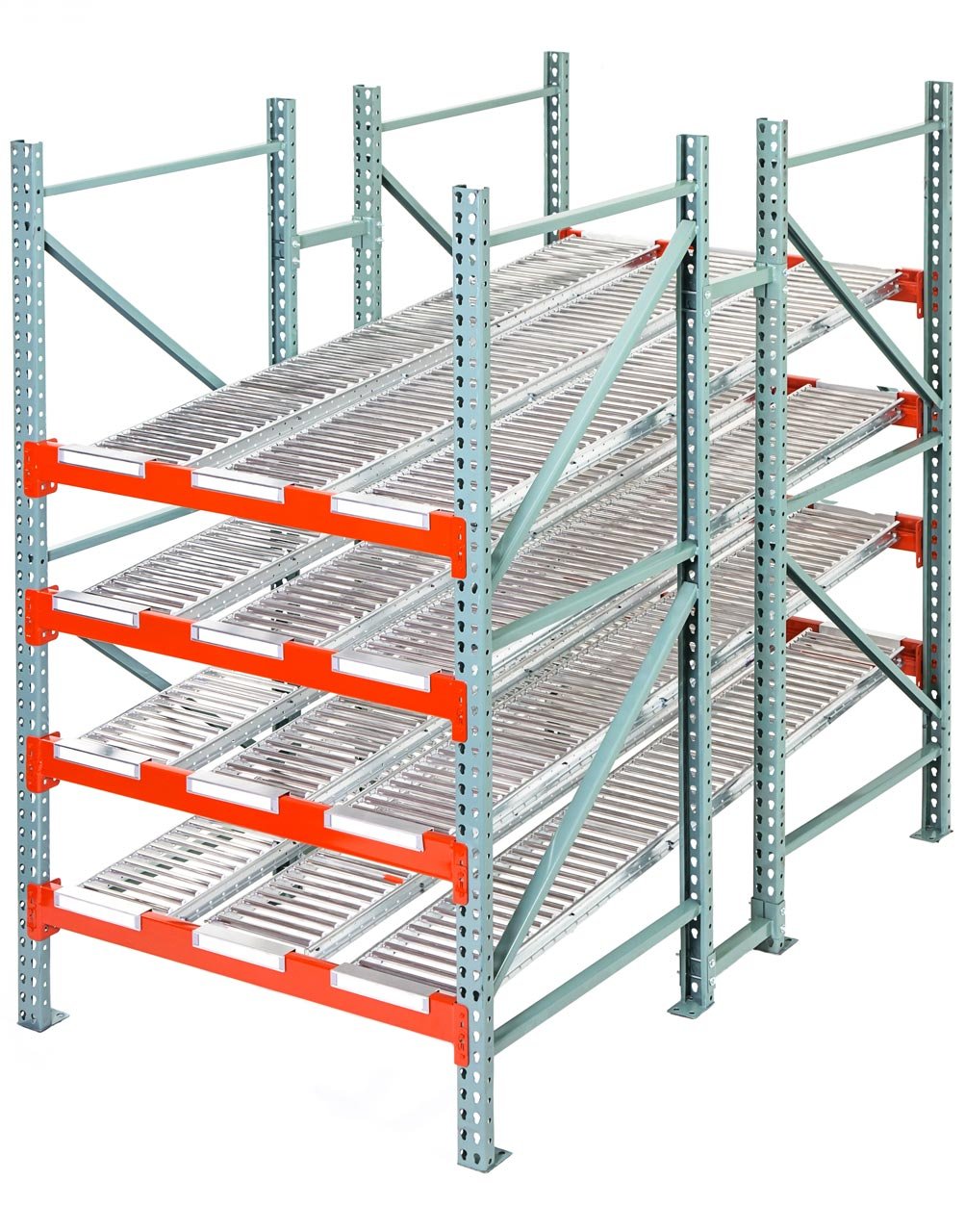
SpanTrack wheel beds are flexible carton flow beds that drop into existing structures to create the ultimate flow rack system for order picking operations, manufacturing facilities, and more.
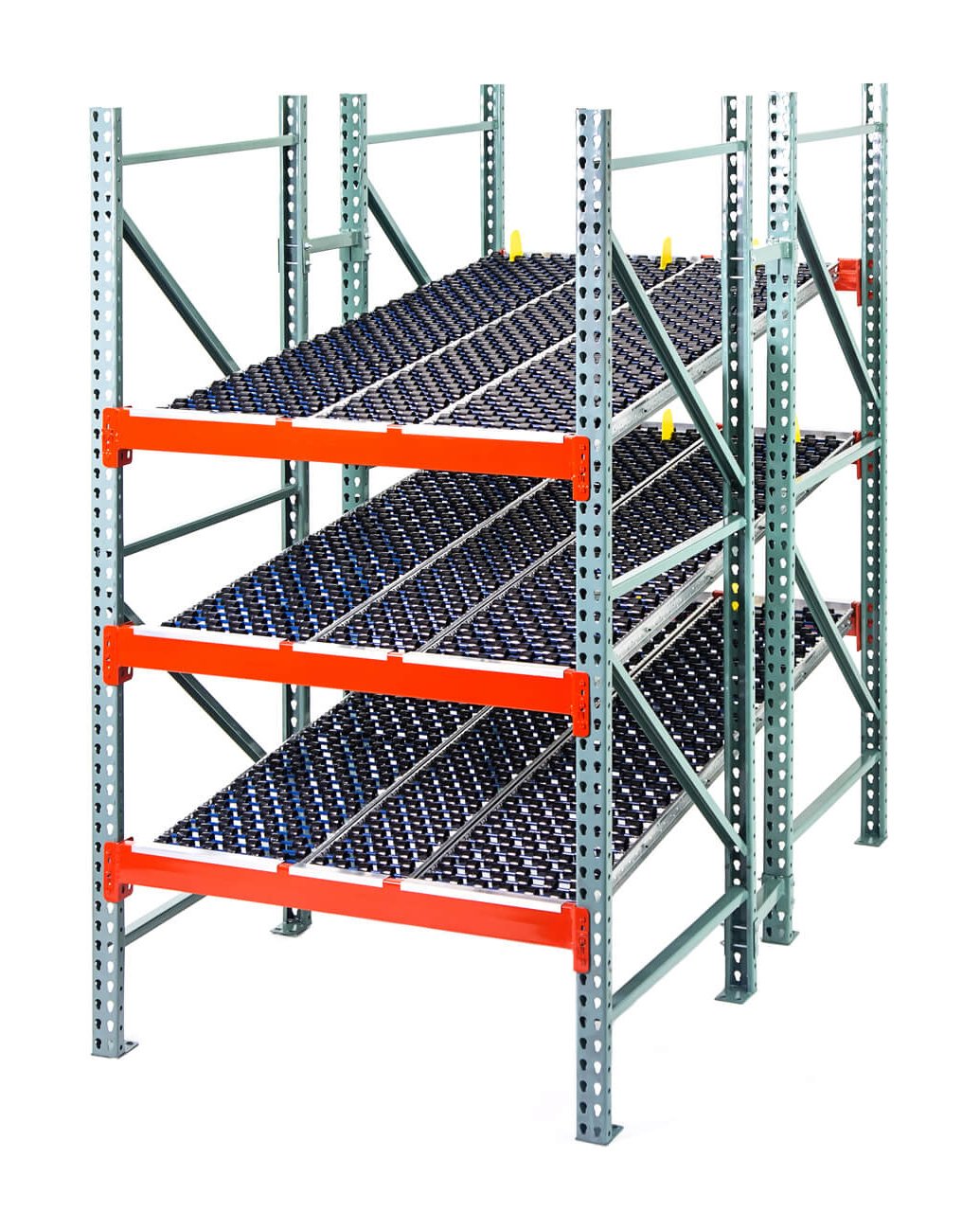
SpeedCell is a dynamic high-density shelving solution that maximizes space utilization within standard pallet racking, helping warehouse and backroom operations improve pick speed and accuracy for valuable time and cost savings.
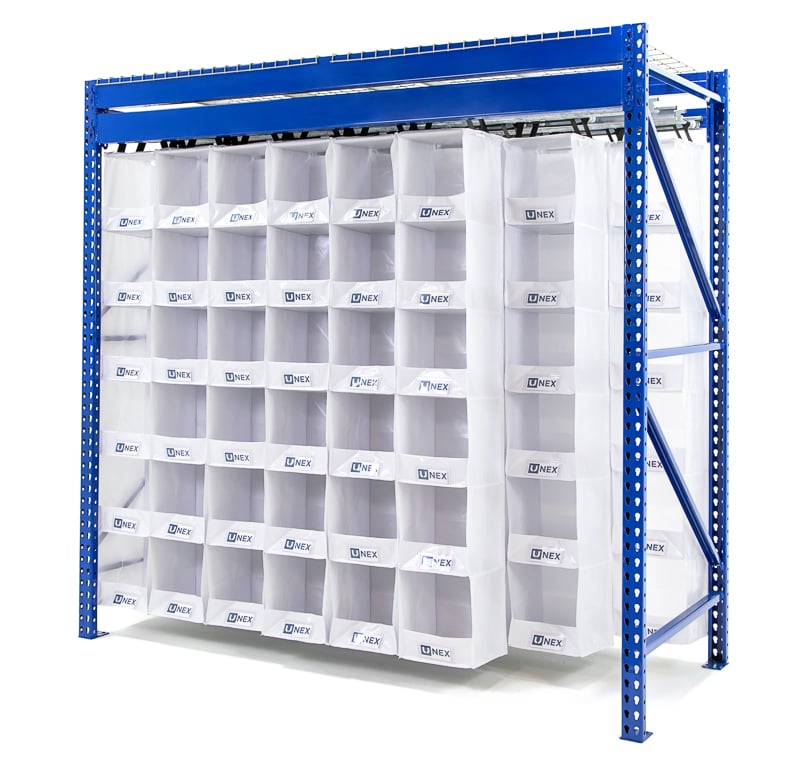
Durable pallet track rollers or wheel rails create a dynamic pallet flow system for fast movers. Our high-quality pallet tracks optimize flow, increase efficiency and storage density, and can be customized to fit an operation’s unique needs.
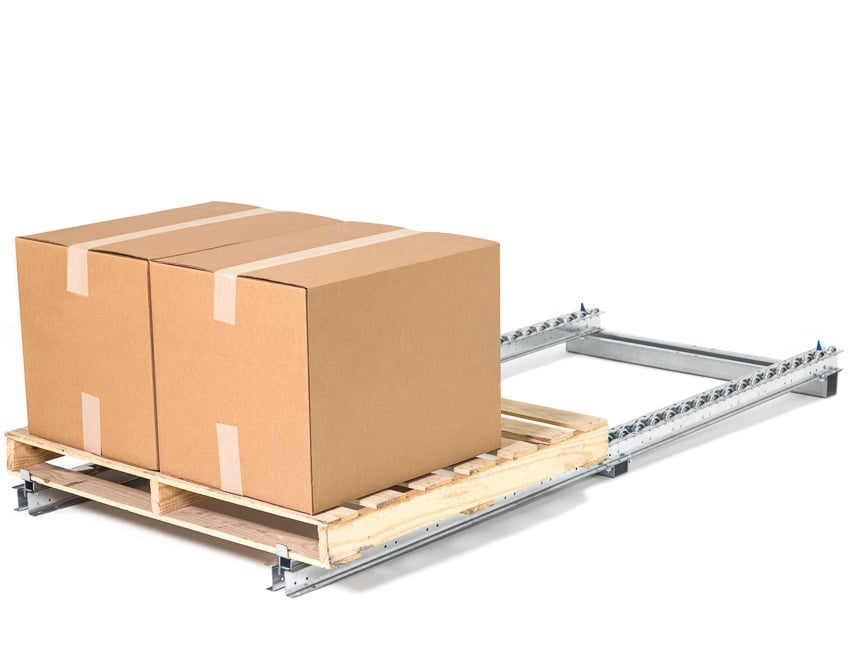
Our tilted pick shelves significantly improve SKU visibility, resulting in faster order picking and more comfortable, precise picks for workers.
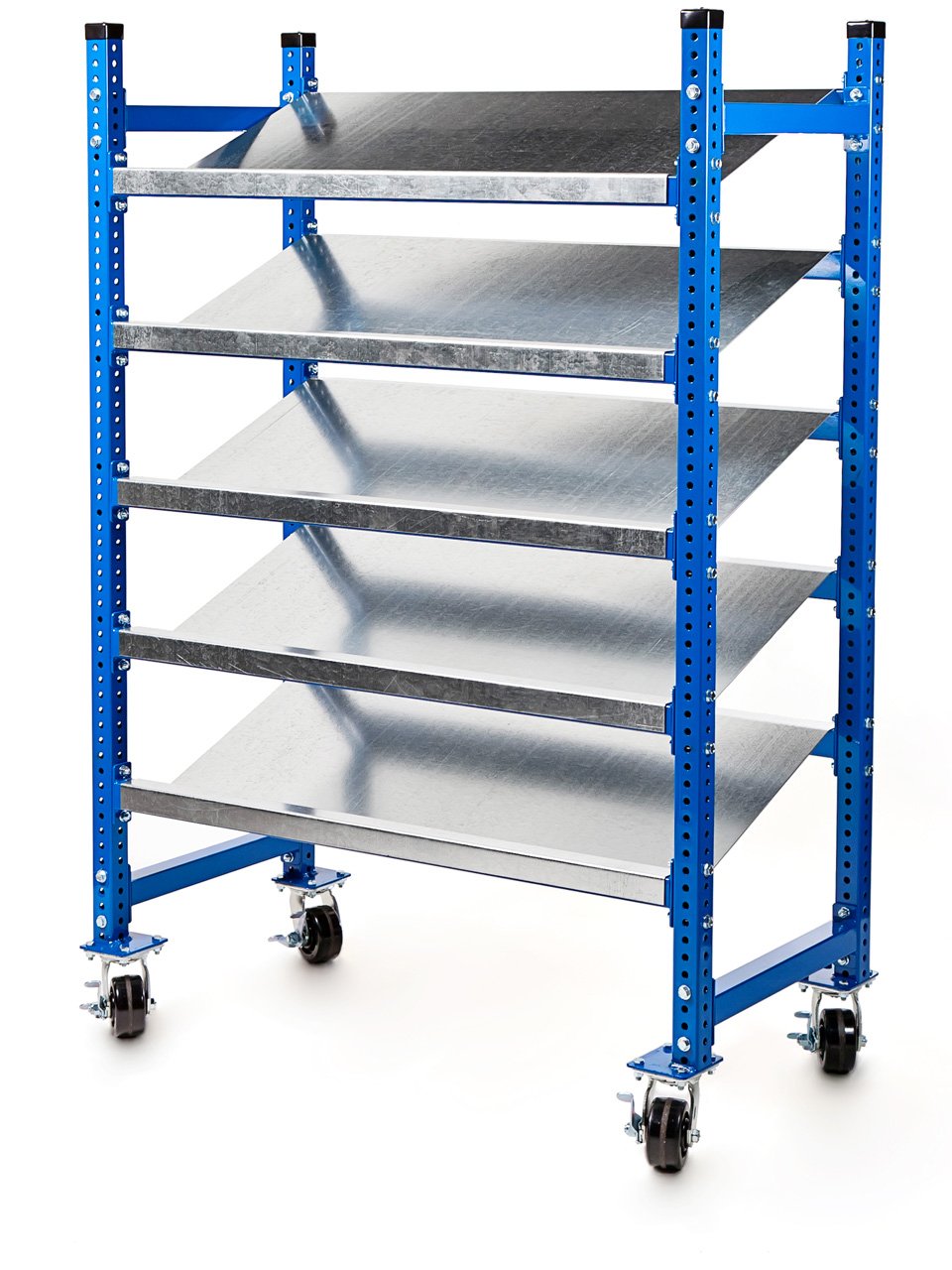
To this end, when you are first planning to optimize your distribution center and implement a slotting system, ask your order pickers for their opinions.
Find out where they’re struggling. Nobody knows the inefficiencies of your distribution center better than the order pickers on the front line. Not only will you get the best information, you’ll also allow them to be part of the solution, further increasing morale.
If you implement those five tips, you will undoubtedly reduce overall cost, increase overall profit, and create a high morale amongst your order pickers. Ready to enhance your facility’s efficiency and maximize your space? Contact UNEX today to discover the best solutions for your operation and take your order picking process to the next level.